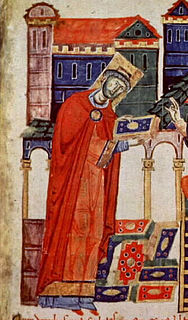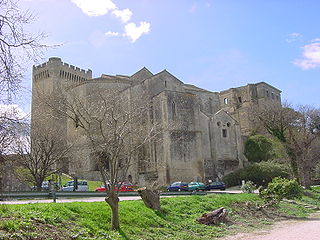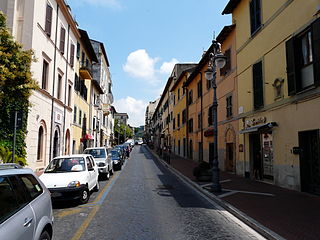


The Abbey of Saint-Victor is a former abbey that was founded during the late Roman period in Marseille in the south of France, named after the local soldier saint and martyr, Victor of Marseilles.



The Abbey of Saint-Victor is a former abbey that was founded during the late Roman period in Marseille in the south of France, named after the local soldier saint and martyr, Victor of Marseilles.
The crypts of the abbey contains artefacts indicating the presence of a quarry that was active during the Greek period and later became a necropolis from 2 BC onward until Christian times. [1]
In 415, Christian monk and theologian John Cassian, having come from the monasteries of Egypt, founded two monasteries at Marseille [1] — the Abbey of Saint Victor for men in the south of the Vieux-Port, as well as the Abbey of Saint Sauveur the other for women in the south of Place de Lenche. [2] [3] [4] The Abbey of Saint Victor was later affected during the fifth century by the Semipelagian heresy, which began with some of Cassian's writings. [4] Both monasteries suffered from invasions by the Vikings and Saracens, [1] and were destroyed in 838 by a Saracen fleet, when the then-abbess Saint Eusebia was also martyred with 39 nuns. [4] In 923, the Abbey of Saint-Victor was destroyed again by the Saracens. [1]
In 977, monastic life was restored in the abbey under the Rule of Saint Benedict through the efforts of Bishop Honorat[ citation needed ] and its first Benedictine abbot Saint Wiffred. [1] It recovered quickly, and from the middle of the 11th century its abbots were requested to restore religious life in the surrounding monasteries that had become decadent. [4]
Saint Isarn (d. 1048), a Catalan monk and successor as abbot to Wiffred, began construction work in 1020, building the first upper church, tower and altar. [1] Isarn was instrumental by his intercession with Ramon Berenguer I, Count of Barcelona, in obtaining the release from Moorish captivity of the monks of Lérins Abbey. Blessed Bernard, abbot of St. Victor from 1064 to 1079, was one of the two ambassadors delegated by Pope Gregory VII to the Diet of Forchheim, where the German princes deposed Henry IV, Holy Roman Emperor. He was seized by one of the partisans of Henry IV and passed several months in prison. Gregory VII also sent him as legate to Spain and in reward for his services exempted St. Victor's from all jurisdiction other than that of the Holy See.
The abbey long retained contact with the princes of Spain and Sardinia and even owned property in Syria. The polyptych of Saint Victor, compiled in 814, the large chartulary (end of the 11th and beginning of the 12th century), and the small chartulary (middle of the 13th century), containing documents from 683 to 1336, document the economic importance of the abbey in the Middle Ages. [4]
Blessed Guillaume Grimoard, who was made abbot of Saint-Victor on 2 August 1361, became pope in 1362 as Urban V. He enlarged the church and surrounded the abbey with high crenellated walls. He also granted the abbot episcopal jurisdiction, and gave him as his diocese the suburbs and villages south of the city. Urban V visited Marseille in October 1365, consecrated the high altar of the church. He returned to St. Victor's in May 1367, and held a consistory in the abbey.
The abbey began to decline after this, especially from the early 16th century, when commendatory abbots acquired authority.
The loss of the important library of the Abbey of Saint-Victor, undocumented as it is, can probably be ascribed to the abuses of the commendatory abbots. The library's contents are known through an inventory of the latter half of the 12th century, and it was extremely rich in ancient manuscripts. It seems to have been dispersed in the latter half of the 16th century, probably between 1579 and 1591. It has been conjectured [5] that when Giuliano di Pierfrancesco de' Medici was abbot, from 1570 to 1588, he broke up the library to please Catherine de' Medici, and it is very likely that all or many of the books became the property of the king.
In 1648 the échevins (municipal magistrates) of Marseille petitioned Pope Innocent X to secularise the monastery, because of the unsatisfactory behaviour of the monks. The Pope was not willing to do so, but instead had the abbey taken over by the reformist Congregation of Saint Maur. Thomas le Fournier (1675–1745), monk of St. Victor's, left numerous manuscripts which greatly assisted them in their publications. [6]
However, the behaviour of the monks generally did not improve, and after their abysmal showing during the plague of 1720, during which they barricaded themselves inside their walls instead of providing any assistance to the stricken, Pope Benedict XIII secularised the monastery in 1726, converting it into a collegiate church with a community of lay canons under an abbot. [7] This was confirmed by a bull of Pope Clement XII dated 17 December 1739. [8]
In 1774, it became by royal decree a noble chapter, the members of which had to be Provençals with four noble descents; from this date they bore the title of "chanoine comte de Saint-Victor". [9]
The last abbot of Saint-Victor was Prince Louis François Camille de Lorraine Lambesc. He died in 1787 and was not replaced before the outbreak of the French Revolution. [10]
In 1794 the abbey was stripped of its treasures. The relics were burned, the gold and silver objects were melted down to make coins and the building itself became a warehouse, prison and barracks. All that now remains of the abbey is the church of St. Victor, dedicated by Pope Benedict IX in 1040 and rebuilt in 1200. The abbey was again used for worship under the First Empire and restored in the 19th century. The church was made into a minor basilica in 1934 by Pope Pius XI. [1]
The remains of Saint John Cassian were formerly in the crypt, along with those of Saints Maurice, Marcellinus and Peter, the body of one of the Holy Innocents, and Bishop Saint Maurontius. [11] The abbey crypt previously held Cassian's remains, along with were previously interred in the abbey crypt, along with the remains of Saints Maurice, Marcellinus, Peter, [4] also has it that it contains the relics of the eponymous martyr of Marseille from the 4th century.

Abbot is an ecclesiastical title given to the male head of a monastery in various western religious traditions, including Christianity. The office may also be given as an honorary title to a clergyman who is not the head of a monastery. The female equivalent is abbess.

Pope Victor III, born Dauferio, was the head of the Catholic Church and ruler of the Papal States from 24 May 1086 to his death. He was the successor of Pope Gregory VII, yet his pontificate is far less notable than his time as Desiderius, the great abbot of Montecassino.

John Cassian, also known as John the Ascetic and John Cassian the Roman, was a Christian monk and theologian celebrated in both the Western and Eastern churches for his mystical writings. Cassian is noted for his role in bringing the ideas and practices of Christian monasticism to the early medieval West.

Montmajour Abbey, formally the Abbey of St. Peter in Montmajour, was a fortified Benedictine monastery built between the 10th and 18th centuries on what was originally an island five kilometers north of Arles, in what is now the Bouches-du-Rhône Department, in the region of Provence in the south of France.

Subiaco is a town and comune in the Metropolitan City of Rome, in Lazio, central Italy, 40 kilometres (25 mi) from Tivoli alongside the river Aniene. It is a tourist and religious resort because of its sacred grotto, in the medieval St Benedict's Abbey, and its Abbey of Santa Scolastica.

Grottaferrata is a small town and comune in the Metropolitan City of Rome, situated on the lower slopes of the Alban Hills, 20 kilometres south east of Rome. It has grown up around the Abbey of Santa Maria di Grottaferrata, founded in 1004. Nearby communes include Frascati, Rocca di Papa, Marino and Rome.

Lérins Abbey is a Cistercian monastery on the island of Saint-Honorat, one of the Lérins Islands, on the French Riviera, with an active monastic community.

Farfa Abbey is a territorial abbey in northern Lazio, central Italy. It is one of the most famous abbeys of Europe. It belongs to the Benedictine Order and is located about 60 km from Rome, in the commune of Fara Sabina, of which it is also a hamlet.

Bobbio Abbey is a monastery founded by Irish Saint Columbanus in 614, around which later grew up the town of Bobbio, in the province of Piacenza, Emilia-Romagna, Italy. It is dedicated to Saint Columbanus. It was famous as a centre of resistance to Arianism and as one of the greatest libraries in the Middle Ages, and was the original on which the monastery in Umberto Eco's novel The Name of the Rose was based, together with Sacra di San Michele. The abbey was dissolved under the French administration in 1803, although many of the buildings remain in other uses.

Ligugé Abbey, formally called the Abbey of St. Martin of Ligugé, is a French Benedictine monastery in the Commune of Ligugé, located in the Department of Vienne. Dating to the 4th century, it is the site of one of the earliest monastic foundations in France. The original abbey having been destroyed during the French Revolution, the current monastic community dates from 1853, and belongs to the Solesmes Congregation.

The Abbey of Saint Maurice, Agaunum is a Swiss monastery of canons regular in Saint-Maurice, Canton of Valais, which dates from the 6th century. It is situated against a cliff in a section of the road between Geneva and the Simplon Pass. The abbey itself is a territorial abbacy and not part of any diocese. It is best known for its connection to the martyrdom of the Theban Legion, its original practice of perpetual psalmody, and a collection of art and antiquity.

Dijon Cathedral, or at greater length the Cathedral of Saint Benignus of Dijon, is a Roman Catholic church located in the town of Dijon, Burgundy, France, and dedicated to Saint Benignus of Dijon. The Gothic cathedral building, constructed between 1280 and 1325, and dedicated on 9 April 1393, is a listed national monument.

Kornelimünster Abbey, also known as Abbey of the Abbot Saint Benedict of Aniane and Pope Cornelius, is a Benedictine monastery that has been integrated since 1972. The abbey is located in Aachen in North Rhine-Westphalia in Germany.

The Abbey of San Giovanni in Venere is a monastery complex in the comune of Fossacesia, in Abruzzo, central Italy. it is located on a hill facing the Adriatic Sea, at 107 m over the sea level.

Orbais-l'Abbaye is a commune in the Marne department in north-eastern France. The abbey at Orbais was founded at the end of the 7th century by Saint Réol, and the remains are situated in the centre of the town.

The Castle of San Servando is a medieval castle in Toledo, Spain, near the Tagus River. It was begun as a monastery, occupied first by monks and later by the Knights Templar.

The Abbey of Saint Scholastica, also known as Subiaco Abbey, is located just outside the town of Subiaco in the Province of Rome, Region of Lazio, Italy; and is still an active Benedictine order, territorial abbey, first founded in the 6th century AD by Saint Benedict of Nursia. It was in one of the Subiaco caves that Benedict made his first hermitage. The monastery today gives its name to the Subiaco Congregation, a grouping of monasteries worldwide that makes up part of the Order of Saint Benedict.

Moissac Abbey was a Benedictine and Cluniac monastery in Moissac, Tarn-et-Garonne in south-western France. A number of its medieval buildings survive including the abbey church, which has a famous and important Romanesque sculpture around the entrance.

The Mont-Saint-Michel Abbey is an abbey located within the city and island of Mont-Saint-Michel in Normandy, in the department of Manche.

The Abbey of Saint Pons is one of the oldest monasteries on the French Riviera, along with Lérins Abbey. It is located in the municipality of Nice in the Alpes-Maritimes. The original abbey was constructed between 774 and 800 and entrusted to the Benedictines. However, in 890, it was destroyed by the Saracens during a failed attack on Nice. The church was rebuilt in 1724 in Baroque style.
The ideal of the ascetic life which had been developed in the Egyptian desert was introduced into Gaul by John Cassian, who founded the monastery of Saint-Victor and nunnery of Saint-Sauveur at Marseilles in 415.
| Wikimedia Commons has media related to Abbaye Saint-Victor . |